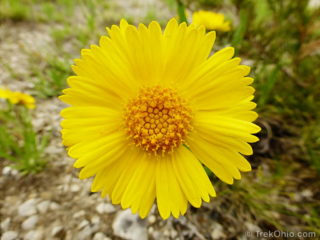 The Lakeside daisy is Ohio's rarest, native plant species. This plant only grows in four areas. Its largest population is in Ohio's Marblehead peninsula, part of Ottawa County. This is where the Lakeside Daisy State Nature Preserve is located. Lakeside daisies are also found in Michigan's upper peninsula, and in Ontario, Canada they can be found in the Bruce Peninsula and Manitoulin Island.
Lakeside daisies are the only representatives of their genus that live east of the Mississippi. Read more ➜
The Lakeside daisy is Ohio's rarest, native plant species. This plant only grows in four areas. Its largest population is in Ohio's Marblehead peninsula, part of Ottawa County. This is where the Lakeside Daisy State Nature Preserve is located. Lakeside daisies are also found in Michigan's upper peninsula, and in Ontario, Canada they can be found in the Bruce Peninsula and Manitoulin Island.
Lakeside daisies are the only representatives of their genus that live east of the Mississippi. Read more ➜ Lakeside Daisy State Nature Preserve
 The Lakeside daisy is Ohio's rarest, native plant species. This plant only grows in four areas. Its largest population is in Ohio's Marblehead peninsula, part of Ottawa County. This is where the Lakeside Daisy State Nature Preserve is located. Lakeside daisies are also found in Michigan's upper peninsula, and in Ontario, Canada they can be found in the Bruce Peninsula and Manitoulin Island.
Lakeside daisies are the only representatives of their genus that live east of the Mississippi. Read more ➜
The Lakeside daisy is Ohio's rarest, native plant species. This plant only grows in four areas. Its largest population is in Ohio's Marblehead peninsula, part of Ottawa County. This is where the Lakeside Daisy State Nature Preserve is located. Lakeside daisies are also found in Michigan's upper peninsula, and in Ontario, Canada they can be found in the Bruce Peninsula and Manitoulin Island.
Lakeside daisies are the only representatives of their genus that live east of the Mississippi. Read more ➜ 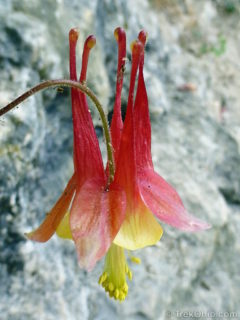 I was delighted at how many species of wildflower were in bloom at Fort Hill this past weekend. We saw many of the same flowers that appeared in April Wildflowers at Lake Katharine State Nature Preserve. So rather than posting duplicate flower photos, I'll just post ones that were newly seen at Fort Hill.
I was delighted at how many species of wildflower were in bloom at Fort Hill this past weekend. We saw many of the same flowers that appeared in April Wildflowers at Lake Katharine State Nature Preserve. So rather than posting duplicate flower photos, I'll just post ones that were newly seen at Fort Hill.
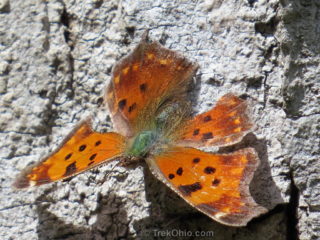 A short while ago I did a post on the Mourning Cloak butterfly. One of the odd things about this butterfly is that it looks like it only has four feet, but it actually has six feet like most insects. It's just that the front two are tiny, little things that the butterfly holds near its body. Someone thought the fuzzy, front feet looked like brushes, so that's how an entire family of butterfly species became known as the Brushfoot family. Today I'm going to look at two other species that are members
A short while ago I did a post on the Mourning Cloak butterfly. One of the odd things about this butterfly is that it looks like it only has four feet, but it actually has six feet like most insects. It's just that the front two are tiny, little things that the butterfly holds near its body. Someone thought the fuzzy, front feet looked like brushes, so that's how an entire family of butterfly species became known as the Brushfoot family. Today I'm going to look at two other species that are members  The Ohio Department of Natural Resources lists Lake Katharine State Nature Preserve as being one of the nine state nature preserves in Ohio that are among the best for seeing spring wildflowers. Having never been to this nature preserve in Jackson County, we decided to see what was blooming there in mid-April.
The Ohio Department of Natural Resources lists Lake Katharine State Nature Preserve as being one of the nine state nature preserves in Ohio that are among the best for seeing spring wildflowers. Having never been to this nature preserve in Jackson County, we decided to see what was blooming there in mid-April.
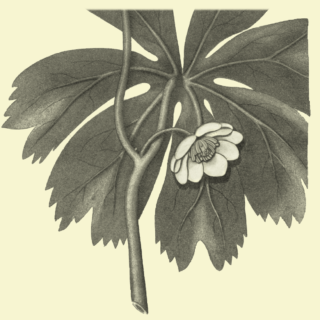 This post illustrates a couple of dozen, common species of spring wildflowers in Ohio. The scientific name in each caption links to an article where you can learn more about that species (a Wikipedia article, if possible). It also lists the months in which you can expect to see each species bloom in central Ohio. In southern Ohio they will bloom a little earlier and in northern Ohio a little later.
Cutleaf Toothwort
The photo below shows some of the foliage.
Mayapple
The blossom
This post illustrates a couple of dozen, common species of spring wildflowers in Ohio. The scientific name in each caption links to an article where you can learn more about that species (a Wikipedia article, if possible). It also lists the months in which you can expect to see each species bloom in central Ohio. In southern Ohio they will bloom a little earlier and in northern Ohio a little later.
Cutleaf Toothwort
The photo below shows some of the foliage.
Mayapple
The blossom 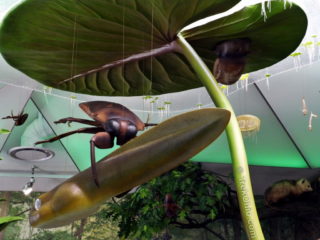 The F. A. Seiberling Nature Realm is a 104 acre Summit County Metro Park. The park has a large 10,000 sq. ft. nature center with exhibits detailing the natural history of the area.
The nature center includes an observation deck overlooking a pond and terrariums containing a number of Ohio reptiles and amphibians. The day we visited an individual associated with the park was introducing visitors to an Eastern Foxsnake (Elaphe gloydi).
There are two and
The F. A. Seiberling Nature Realm is a 104 acre Summit County Metro Park. The park has a large 10,000 sq. ft. nature center with exhibits detailing the natural history of the area.
The nature center includes an observation deck overlooking a pond and terrariums containing a number of Ohio reptiles and amphibians. The day we visited an individual associated with the park was introducing visitors to an Eastern Foxsnake (Elaphe gloydi).
There are two and 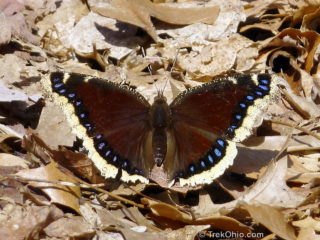 A few days ago, I was able to photograph my first butterfly of the year, a Mourning Cloak Butterfly. The reason the outer edges of its wings are frayed already is because it has been hanging out in Ohio all winter… well, not exactly hanging out. When it's very cold, this butterfly sneaks into a crack in a tree or some other little nook and hibernates there until it gets warmer. And it doesn't necessarily wait till spring. Whenever we are having unseasonably warm, winter weather, there is some chance
A few days ago, I was able to photograph my first butterfly of the year, a Mourning Cloak Butterfly. The reason the outer edges of its wings are frayed already is because it has been hanging out in Ohio all winter… well, not exactly hanging out. When it's very cold, this butterfly sneaks into a crack in a tree or some other little nook and hibernates there until it gets warmer. And it doesn't necessarily wait till spring. Whenever we are having unseasonably warm, winter weather, there is some chance  After a walk at Wahkeena Nature Preserve, Bob and I stopped to chat with Robyn. Robyn is one of the naturalists at Wahkeena, and she was the original author of the Wahkeena Nature Preserve blog. Robyn asked us how our walk went. I mentioned that I had seen lots of amphibian eggs in pools of water, but I didn't know how to tell the difference between frog eggs and salamander eggs. She offered then and there to show us the difference.
We went to a little pool and Robyn lifted up two groups of eggs
After a walk at Wahkeena Nature Preserve, Bob and I stopped to chat with Robyn. Robyn is one of the naturalists at Wahkeena, and she was the original author of the Wahkeena Nature Preserve blog. Robyn asked us how our walk went. I mentioned that I had seen lots of amphibian eggs in pools of water, but I didn't know how to tell the difference between frog eggs and salamander eggs. She offered then and there to show us the difference.
We went to a little pool and Robyn lifted up two groups of eggs  Like much of the northern part of the country, we had a spring snow last night. Today I decided to go on a wintry spring walk at Inniswood Metro Garden to see how the flowers were faring. I invite you to come along!
And here's what the grounds looked like.
And finally I took a look at the children's garden.
The early blooming flowers are pretty hardy, so I'm guessing they'll be okay. I've even heard that the snow insulates and protects them
Like much of the northern part of the country, we had a spring snow last night. Today I decided to go on a wintry spring walk at Inniswood Metro Garden to see how the flowers were faring. I invite you to come along!
And here's what the grounds looked like.
And finally I took a look at the children's garden.
The early blooming flowers are pretty hardy, so I'm guessing they'll be okay. I've even heard that the snow insulates and protects them 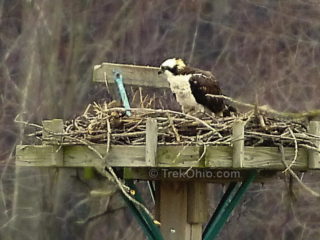 The osprey have returned to the northern edge of Hoover reservoir. Osprey are brown and white birds of prey measuring two feet (61 cm) tall with a wingspan of almost six feet (183 cm). They build nests near water and feed on fish.
Like almost all of our other wildlife, ospreys disappeared from Ohio in the early 1900s. According to an article by John Switzer in the Columbus Dispatch the reintroduction of ospreys in modern times occurred when a breeding pair migrated into the state of
The osprey have returned to the northern edge of Hoover reservoir. Osprey are brown and white birds of prey measuring two feet (61 cm) tall with a wingspan of almost six feet (183 cm). They build nests near water and feed on fish.
Like almost all of our other wildlife, ospreys disappeared from Ohio in the early 1900s. According to an article by John Switzer in the Columbus Dispatch the reintroduction of ospreys in modern times occurred when a breeding pair migrated into the state of